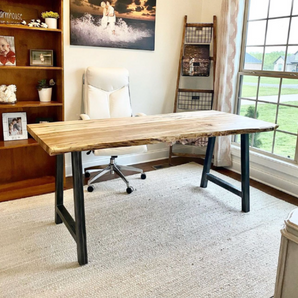Dining Room Table Legs: What to Consider Before You Acquire
Dining Room Table Legs: What to Consider Before You Acquire
Blog Article
A Detailed Look at Eating Table Leg Styles: Locating the Perfect Suit
Picking the best eating table leg style is important for both aesthetic appeal and functional functionality. For those with larger tables, trestle legs guarantee tough support, whereas barrette legs introduce a mid-century modern vibe with their minimalist layout. The x-shaped legs mix contemporary style with improved stability.
Conventional Four Legs
Amongst the various sorts of table leg styles, the conventional four-leg design continues to be an ageless selection for many households. This traditional arrangement offers a harmonious blend of performance and visual appeals, making it a seasonal fave. 4 legs give balanced assistance, making certain the table continues to be stable and efficient in bearing substantial weight. This is specifically beneficial for families that frequently organize big celebrations or use their table for numerous functions, such as work or crafting.
From an aesthetic viewpoint, the traditional four-leg layout can be conveniently adapted to different interior styles. Whether crafted from wood, metal, or a mix of materials, these legs can be intricately carved, sleek and minimalistic, or anything in between. Their flexibility permits them to complement both rustic and modern setups flawlessly.
Moreover, the uncomplicated structure of the four-leg layout promotes convenience of motion and positioning within a room. Unlike more complicated bases, this style minimizes obstructions, supplying enough legroom for diners. In summary, the traditional four-leg table leg style weds withstanding style with functional performance, making it a sharp selection for those looking for both kind and feature in their dining furnishings.
Pedestal Base
Commonly celebrated for its stylish and space-efficient style, the pedestal base is a distinguished option to the conventional four-leg setup in table leg styles. This unique base usually includes a single main column supporting the tabletop, which can differ in form, from ornately carved wood to smooth, contemporary metal. Among the main advantages of the pedestal base is its capability to take full advantage of legroom and seating adaptability. Without corner legs, diners are paid for better freedom of motion, making it a perfect choice for round and oblong tables that promote more intimate and comprehensive gatherings.
Moreover, the pedestal base's central assistance can take care of significant weight, permitting making use of heavier tabletops, such as marble or thick hardwood. This toughness combined with its aesthetic flexibility makes the stand base a preferred choice in both standard and modern interior settings. It can effortlessly incorporate with various style motifs, from classic beauty to minimal modernity. Additionally, the main column itself offers a canvas for complex designs and imaginative expressions, adding an weblink aspect of visual rate of interest under the table. In recap, the pedestal base incorporates performance snappy, making it an improved and practical option for diverse eating atmospheres.
Trestle Legs
Trestle legs supply a durable and classic foundation for eating tables, characterized by their straight cross-bracing and tough support beams. Originating from medieval times, this layout has developed yet maintained its necessary structure, making it a perennial favorite in both typical and modern settings. The main trestle beam, often sustained by 2 or more vertical posts, offers exceptional security, permitting larger table lengths without the demand for additional legs.
A substantial benefit of trestle leg tables is the enough legroom they offer. Unlike tables with 4 edge legs, the lack of obstructions at the table's sides provides unblocked space for chairs and restaurants, enhancing comfort and availability. This makes trestle tables optimal for accommodating larger celebrations, whether in a dining-room or a banquet hall.
The aesthetic convenience of trestle legs is noteworthy. Readily available in a variety of materials such as timber, metal, and composite, they can be ended up to enhance a wide variety of interior designs. From rustic farmhouse to sleek contemporary styles, trestle legs can be customized to match individual preferences. linked here Their enduring appeal and practical benefits make trestle legs an engaging selection for those seeking both style and practicality in their table.
Barrette Legs

The allure of hairpin legs depends on their simpleness and convenience - dining room table legs. Readily available in a series of products, including steel and brass, they can be finished in countless shades to match different indoor designs. Whether combined with a rustic wood table top or a contemporary glass surface area, hairpin legs effortlessly mix capability with a touch of vintage beauty
Resilience is an additional significant attribute of barrette legs. see here Despite their fragile look, these legs are engineered to bear considerable weight, ensuring the table remains secure and safe and secure. In addition, they are fairly very easy to set up, making them a preferred choice for DIY fanatics and specialist furnishings manufacturers alike.
X-Shaped Legs

Built from products such as steel, timber, or a combination of both, X-shaped legs can be tailored to match different style choices. Steel legs often provide a streamlined and commercial feel, ideal for loft-style apartment or condos and modern-day eating rooms.
Additionally, the design behind X-shaped legs makes sure even weight distribution, reducing the risk of wobbling and enhancing resilience. This makes them especially appropriate for bigger table that need extra support. Fundamentally, X-shaped legs blend useful engineering with contemporary appearances, making them a timeless choice for diverse eating environments.
Final Thought
A thorough understanding of dining table leg styles exposes the unique qualities and advantages of each style. Trestle legs make certain robust support for larger tables, and hairpin legs introduce a mid-century modern aesthetic.
Report this page